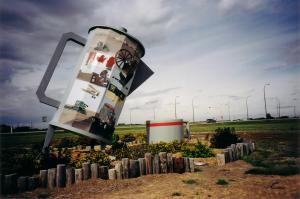

Town, pop 1,035, located about midway between Regina and Saskatoon on Hwy 11. The railway through the area was built in the late 1880s. Trains were running the distance from Regina through Saskatoon and on to Prince Albert in 1890. The first residents of the Davidson area were the Meshen family. Charles Meshen was a section foreman for the railroad; between 1899 and 1902, he and his family spent the summer months living out of a boxcar just south of the present townsite. The location was known as Finsbury, and while Meshen spent his days seeing to the maintenance of the track through the area, the vast region was still deemed to be a desert-like wasteland. In 1902, at the urging of the Canadian government, Colonel Andrew Duncan Davidson formed the Saskatchewan Valley Land Company and began aggressive campaigns to promote immigration to the area. As much of Davidson's advertising was aimed at Americans, his marketing strategy included naming some of the townsite’s streets after former US presidents. Andrew Davidson was immensely successful: the first few settlers arrived in 1902, but in 1903 waves of homesteaders began pouring into the region. The Meshens built a house in town that year, the post office was established, and by early 1904 about 15 businesses were in operation--largely in makeshift shacks. Two years later, the population of the community was over 500, and on November 15, 1906, Davidson became a town. It developed into a trading centre for a large area that included the Watrous, Long Lake, Elbow, and Outlook districts, and soon earned the nickname “The Midway Town” because of its location between the cities of Saskatoon, Regina and Moose Jaw. Today, Davidson serves an immediate trading area of over 10,000 people and has a wide array of business providing a variety of goods and services. Davidson is also one of the province’s major grain handling points and agricultural service centres. Its weekly newspaper, the Davidson Leader , was established in 1904. Because of the community's central location, it has become established as a meeting place for businesspeople and a variety of organizations from Saskatchewan’s major cities. Its 7.3-metre-high coffee pot, situated on the highway, symbolizes the town's position as a hospitality centre.
David McLennan